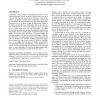Free Online Productivity Tools
i2Speak
i2Symbol
i2OCR
iTex2Img
iWeb2Print
iWeb2Shot
i2Type
iPdf2Split
iPdf2Merge
i2Bopomofo
i2Arabic
i2Style
i2Image
i2PDF
iLatex2Rtf
Sci2ools
COMPGEOM
2004
ACM
2004
ACM
Low-dimensional embedding with extra information
A frequently arising problem in computational geometry is when a physical structure, such as an ad-hoc wireless sensor network or a protein backbone, can measure local information about its geometry (e.g., distances, angles, and/or orientations), and the goal is to reconstruct the global geometry from this partial information. More precisely, we are given a graph, the approximate lengths of the edges, and possibly extra information, and our goal is to assign coordinates to the vertices that satisfy the given constraints up to a constant factor away from the best possible. We obtain the first subexponential-time (quasipolynomial-time) algorithm for this problem given a complete graph of Euclidean distances with additive error and no extra information. For general graphs, the analogous problem is NP-hard even with exact distances. Thus, for general graphs, we consider natural types of extra information that make the problem more tractable, including approximate angles between edges, th...
| Added | 30 Jun 2010 |
| Updated | 30 Jun 2010 |
| Type | Conference |
| Year | 2004 |
| Where | COMPGEOM |
| Authors | Mihai Badoiu, Erik D. Demaine, Mohammad Taghi Hajiaghayi, Piotr Indyk |
Comments (0)

